Line Cruiser Rivalry: Moltke vs. Lion. H. 2
The fact is that in the world then there were two methods of making tools. Germany and Russia used the method of "fastened cylinders" when the gun barrel was assembled from several cylinders that were very precisely matched to each other. At the same time, England, in the old manner, used "wire" technology. Its meaning was that an inner tube was taken, several layers of high-strength calibrated steel wire were wound on it, and then placed in another tube and a cylindrical casing on top. The advantage of this system was that the production of tools was relatively cheap, since less expensive carbon steel could be used for external pipes and casings. But the “wire” system also had its drawbacks: for example, British guns were much heavier. The English 305-mm / 50 gun Mark XI had a mass of 67 770 kg, and a weaker 305-mm / 45 Mark X - 58 626 kg. At the same time, the much more powerful German 305-mm / 50 SK L / 50 had a weight of 51 850 kg, the Russian 305-mm / 52 artillery system - 50 700 kg.
However, the increased mass was not the main drawback of the “wire” artillery systems. Many domestic authors, such as B.V. Kozlov, V.L. Kofman, note the low longitudinal strength of such guns, which led to the deflection of the barrel and vibration when fired, which increased the dispersion of projectiles. Apparently, this deficiency practically did not manifest (although ... not for this reason, did the accuracy of firing of British battleships and battlecruisers with 305-mm guns at long distances fall?) In relatively short-barreled 40-45-caliber artillery systems, but it became noticeable with tool elongation above 45 gauges.
At the same time, O. Parks notes that the 305-mm / 50 Mark XI was less accurate than the 343-mm tools, but it does not specify the reasons. But a larger-caliber gun can be superior in accuracy over a smaller one simply due to the greater kinetic energy of the projectile, due to which it has less dissipation at the same distance. Thus, O. Parks does not confirm, but does not refute our authors. On the other hand, an indirect confirmation of their point of view can be that, after the 305-mm / 50 Mark XI, the British never created large-caliber guns over 45 gauges in length.
Accordingly, the author of this article assumes that story the appearance of super dreadnoughts looked like this. Shortly after the Russian-Japanese war, due to the gradual increase in the size of the battleships, and also (which was probably more important) the distance of fire fighting, fleets around the world began to feel the need for more powerful artillery systems than they had before. Many countries took the path of creating more powerful 280-305-mm artillery systems with increased barrel length - Germany, USA, Russia brought the length of their guns to 50 calibers. England also made a similar attempt, adopting the 305-mm / 50 Mark XI, but it was not very successful. At the same time, a return to 45-caliber 305-mm guns would certainly put the UK in a lagging position. Not being able to create long-barreled guns, Britain could only compensate for this by increasing the caliber of the guns - and so the 343-mm / 45 artillery systems appeared.
However, regardless of the reasons that prompted the British to go to the 343-mm caliber, it should be recognized that this artillery system was significantly superior in firepower to any 305-mm gun in the world. But how much? Here, alas, all very difficult.
First, the British 343-mm / 45 guns were equipped with so-called "light" and "heavy" shells, the first had a weight of 567 kg (although 574,5 kg are also present in the same line), the second - 635 kg. Both the “light” and “heavy” lines of shells included armor-piercing, semi-armor-piercing and high-explosive shells. But why did the British have to introduce such "imbalance"?
As far as the author of this article could figure it out, this was the case. Initially, the Mark V 343-mm / 45 guns were made using an 567 kg projectile, and it was such shells that were used to assemble the first super-draws of the Orion series and the battle cruiser Lion. But later on, more effective 13,5 kg shells were created for 635-inch guns - we observe something similar when developing a domestic 305-mm / 52 gun, which was originally created under a lightweight 331,7 kg shell, but later 470,9 kg was adopted for it "suitcase".
However, by the time the British got ready to switch to 635 kg shells, the work on the Orions and Lion was in such a stage that it was considered unreasonable to redo their feed mechanisms. In other words, it turned out that the Orion and Lion 343-mm cannons, without a doubt, could have fired 635 kg with shells, but their gun delivery systems could not “turn over” them. As a result, the new British battleships and battlecruisers, starting with "King George V" and "Princess Royal" got 635 kg shells, while the "Orion" and "Lion" had to be content with 567 kg. At the same time, when after the Battle of the Yutland it became clear that with the British armor-piercing shells "something was wrong", the British created new Greenboy ammunition that had an 574,5 kg weight for Orion and Lion and a 639,6 kg for subsequent super dreadnoughts armed with 343-mm guns.
But with what initial speed the English 13,5-inch guns fired, the author of this article did not figure it out.
The 899 m / s and 863 m / s for some "light" and "heavy" projectiles given in some publications are obviously erroneous. Such an initial speed had British 343-mm cannon guns, but not the ship's. O. Parks (and many monographs after him) indicate 823 m / s for “light” and “heavy” projectiles, but this is most likely not true.
It is well known that with an equal charge, a heavier projectile will have a lower initial velocity, and that in order to equalize initial velocities with a lighter one, it will need a much more powerful powder charge. In this case, of course, increased pressure will reduce the life of the barrel. Therefore, the transition to heavier projectiles is usually accompanied by a certain drop in its initial velocity, but O. Parks argues that this did not happen. But here we are faced with such an oddity: according to O. Parkes, the charge for 635 kg of the projectile was heavy only on 1,8 kg (132,9 kg for “light” and 134,7 kg for “heavy” shells). The question arises: could the charge, with an increase in the mass of gunpowder by less than 1,4%, send a projectile weighing almost 12% into flight with the same initial velocity? It looks extremely doubtful.
Perhaps the initial speed of 823 m / s had a “light”, 567 kg projectile, and the “heavy” - a slightly lower projectile, but the author could not find such data. V.B. Mujenikov indicates 788 and 760 m / s, respectively. The popular electronic encyclopedia navweaps.com gives the initial speed 787 m / s for 567 kg projectile and 759 m / s for 635 kg, but unfortunately, no references to the source of information are given. And without the appropriate links, the data of navweaps.com is still better not to use, since this encyclopedia contains a sufficient number of errors, and cannot be considered as some reliable source.
But even if we take the lowest of all the above initial speeds (787 m / s for the “light” projectile), in this case 567 kg of ammunition, leaving the gun, had a kinetic energy approximately 20% better than that of the German 305-mm / 50 guns. But besides energy, the power of the munition should also be taken into account, and here the 343-mm projectile also has a tangible superiority. Armor-piercing 305-mm German projectile was loaded with 11,5 kg of explosive, high-explosive - 26,4 kg. The British “light” armor-piercing projectile initially had 18.1 kg, and the “heavy” 20,2 kg of explosives, but then the question arises of the correctness of the comparison, because, as you know, the British projectiles when hit by thick armor plates (which, nevertheless, they theories were supposed to pierce) had a tendency to detonation or destruction before, or at the time of the passage of the armor plate. But the full-fledged Greenboy armor-piercing shells, which in terms of quality fully corresponded to the German ammunition of the same purpose, had a slightly lower explosive content - 13,4 and 15 kg, respectively. Thus, they exceeded the German 305-mm projectiles in explosives content on 16,5-30,55%, and this is certainly extremely weighty.
As for high-explosive shells, here the superiority of the British 343-mm “suitcases” was simply overwhelming — and the “light” and “heavy” “land mines” were carrying 80,1 kg of liddite, which more than tripled (!) More than the content of explosives of German 305-mm projectile. Of course, it can be said that the Germans, in general, have never been leaders in explosives in ammunition of this type, but even the extremely powerful Russian high-explosive 470,9 kg projectile had a maximum of 61,5 kg of explosives.
In general, it should be stated that the British created a very powerful weapon, in their qualities knowingly superior to any 280-305-mm artillery systems of the world and were the first to arm their ships with such guns: including the battle cruiser Lion.
It must be said that the Lion in general became a largely revolutionary ship, and not only because of the placement of heavy 343-mm cannons on it. The fact is that until recently many ideas of the British Admiralty were not embodied in the metal due to the need to save money. But by 1909, the circumstances were such that they made the British government forget about saving.
Until recently, England apparently led the construction of the newest classes of warships, defining the sea power of the state, which became the dreadnoughts and battle cruisers. The Dreadnought, three Bellerophon ships, then three Saint Vincent dreadnoughts, and in addition to them three Invincible battlecruisers, and all in all ten large ships, with which Germany opposed twice as small forces — four a battleship of the type "Nassau" and the battle cruiser "Von der Tann" ("Blucher" we, of course, will not be included in this list). In other words, before 1908 g, Great Britain laid large ships at a margin of two to one against its main continental enemy, and Misty Albion allowed itself to relax - only two large ships, the battleship Neptune and the battle cruiser Indefatigable, were laid down under the 1908 g program.
But Germany has demonstrated that it is able to “slowly harness and drive fast” and according to the program of the same, 1908 r laid down four large ships - three dreadnought type “Helgoland” and the battle cruiser Moltke. The English program of the next year, 1909, was supposed to lay out three more dreadnoughts and one battlecruiser, but the Germans were preparing to respond mirror-like, with the same number of battleships and battlecruiser.
All this has pretty agitated the UK - until recently the double superiority in large ships somehow imperceptibly turned into 16 against 13, which, of course, did not suit the "Lady of the seas" at all. In addition, in England they believed that the matter was going to war and therefore made a “knight's move”: they doubled the 1909 g program, having found money for 6 dreadnoughts and two battlecruisers, but the main thing - they canceled the economic restrictions on new projects of large ships. In other words, for the first time in the history of the dreadnought race, admirals and designers of Great Britain were able to not look back at government financiers when designing new types of ships (within reasonable limits, of course).
As a result, the Orion-type super-middones have become larger on the 2 500 and larger than the previous Colossus and Hercules battleships (although O. Parks might have used the “rounding up” technique) and the difference was slightly smaller - 2 275 ), but, in any case, it really was a huge leap forward - before that, the increments in displacement of British "capital" ships from series to series were much more modest.
But "Lion" ... he broke all conceivable records. The actual displacement of the “Indefatigeble” was 18 470 t, and the newest British battlecruiser with 343-mm guns had the 26 600 t, that is, the increase in displacement was 8 130 t! If we compare the design displacement of cruisers (18 750 and 26 350 tons, respectively), the difference will be somewhat smaller, but it is still enormous - 7 600 tons. Let's see where the additional tons went, comparing the weight data of the cruisers (in brackets - weights " Indefatigebla "):
Equipment - 760 (680) t;
Artillery - 3 260 (2 580) t;
Machines and mechanisms - 5 840 (3 655) t;
Normal fuel capacity - 1 000 (1 000) t;
Armor - 5 930 (3 735) t;
Enclosure - 9 460 (7 000) t;
Displacement stock - 100 (100) t;
Total normal displacement - 26 350 (18 750) t.
The biggest gain is the power plant (59,8%), after which the armor (58,8%) is almost equal to it, the hull is 35,1%, and the artillery is only 26,4%. The smallest increase in the equipment (less than 12%), but it, in fact, did not affect anything - the difference was only 80 t. But, of course, we will look at Lion in more detail.
weaponry
About the main caliber of the third generation of British battlecruisers, we have already said a lot, and we will not repeat. We only mention that eight 343-mm guns were located in the center plane, but linearly sublime - only two bow towers, and the third was located between the engine rooms. As a result of this placement of the shelling sector, the guns of the Lion were (on one side): 0-30 hail (where zero is right along the ship's course) - 4 guns, 30-150 hail. - 8 guns, 150-180 hail - 2 guns.
Before the war, ammunition peacetime was 80 shots. on the gun and included 24 armor-piercing, 28 semi-armored, 28 high-explosive and 6 shrapnel shells. In wartime, ammunition increased to 110 projectiles, including 66 armor-piercing, 22 semi-armor and 22 high-explosive. However, after the Battle of Jutland, the number of high-explosive shells was first recommended to be reduced to 10 and then eliminated altogether, leaving 55 armor-piercing and 55 semi-armor-piercing shells. The final version, after the appearance of "Greenboy" - 77 armor-piercing and 33 semi-armored projectile.
Mine artillery made up the 16 102-mm / 50 Mark VII guns, firing 14,06 kg shells with an initial speed of 873 m / s. They were placed in the ship's superstructures, eight in the fore and aft. The British themselves considered such an arrangement to be a good one, since the superstructures had a form that allowed them to shoot 6 guns at the bow, 4 - at the stern and 8 - at any side. Ammunition was 150 shots at the gun (according to some, in wartime, was increased to 200).
In addition, four 47-mm salute guns were installed on the Lion. Torpedo armament did not differ from that on the “Indefatigeble” and consisted of two 533-mm underwater vehicles, perpendicular to the board in front of the barbet of the main-caliber bow tower (the first). Ammunition consisted of 14 torpedoes.
Power plant
Usually, when analyzing the characteristics of a ship, we consider first the armor, and only then the driving performance, but today we will make an exception, since it is very important to know the specifics of its power plant to understand the features of Lion’s booking.
Before the Lion, the speed of the British battlecruiser can be considered 25-25,5 knots, but the newest ship was given a more ambitious goal - it had to develop 27 knots (with normal displacement, of course). To do this, the ship in 26 with more than a thousand tons required heavy-duty power plant in 70 000 HP - Recall that the nominal power of the machines "Indefatigebla" was "only" 43 000 hp, i.e. an increase of 62,8% was required.
Of course, it was absolutely impossible to "shove" cars and boilers of similar power into the dimensions of "Indefatigeble". As a result, the Lion's corpus turned out to be much larger - it was longer than the “Indefatigebla” on 33,6 m, wider on 2,6 m, the draft was on 45, see
Tests "Lion" at full speed were carried out in difficult weather conditions, probably therefore the desired result was not achieved. During the 8 hourly run, the battlecruiser developed the average speed of 27 knots, but with a slightly higher power machine than the nominal 73 800 HP. At the same time, he is of the same type “Princess Royal” on 78 600 hp has developed an average speed of 28,5 bonds, and "Queen Mary" on 78 700 hp - 28 knots., So it can be assumed that, if not the influence of bad weather, then the contractual conditions for speed “Lion” would fulfill. Nevertheless, the Admiralty was unhappy with the result: apparently, under the influence of the first series of battle cruisers, which, when forcing vehicles, reached speeds above 27 knots, no less than 29 knots were expected from Lion-type ships.
The normal supply of fuel was 1 000 tons, full - 3 500 tons of coal and 1 135 tons of oil. Travel range indicates 4 935 miles at 16,75 knots and 5 610 miles on 10 nodes.
Reservation
Without a doubt, the British admirals and designers paid close attention to booking a new type of battlecruisers - this is evidenced by an increase in the mass of armor by almost 60% in comparison with the previous project. They undoubtedly managed to improve something, but here, by and large, she found a stone on the stone - the fact is that the additional displacement that could be allocated to armor could not "keep up" with the growth of the geometric dimensions of that should be protected - and first of all the citadel.
As you know, the citadel then fully performs its function, if it protects not only the engine and boiler rooms, but also covers the feed tubes of the end towers of the main caliber, but this distance from the British battlecruisers grew from project to project. The distance between the axes of the Invincible end towers was 91 m, but in the Inflexible project, due to the need to spread the traverse towers closer to the extremities, it was already 112 m on Lyon, all four towers were located in the center plane, and except for Moreover, the barbety of the 343-mm guns were wider than the 305-mm turrets, but this would not give a large increase in the length of the citadel. The main reason for the need to increase it was the gigantic increase in the power of the mechanisms, which required an increase in the length of the engine and boiler rooms. As a result, the distance between the axes of the end towers of the Lion was 128,4 m., Respectively, the length of the citadel (so that the armor belt covered the board within the barbets of the bow and stern towers) was at least 137 meters! And this is a colossal length for ships of those years.
The Lion finally got the 229 mm armor belt, which the British sailors would like to see on Indefatigable. It was very high (3,5 m) and extended (116 m), but at the same time it covered only the engine and boiler rooms of the battlecruiser - “stretch” it another 21 meter so that it provided protection for the supply pipes and artillery cellars of two nasal and aft towers main caliber British designers failed.
From the 229 mm belt to the nose, the boards were protected by armor plates of the same height, 3,5 m, but its thickness gradually decreased. During the first 14 m (from the nose house, covering the supply pipe of the second tower and up to the barbet of the first tower of the main caliber), its thickness was 152 mm, then, over the following 8,5 m, opposite the barbet of the first tower - 127 mm and further, over the 26 m - 102 mm. Bronepoyas did not reach the 15,2 stem, and where it was completed, the beam was set to a thickness of 102 mm.
The 229 mm, and then the 127 mm armor plates, went to the stern of 102 mm of armor belt, they also defended 11,3 m side opposite the stern tower of the main caliber. On this armored belt ended in the same way as in the nose of the 102 mm by means of the beam, the remaining 22,3 and board did not have armor protection to the stern-bow. Thus, the total length of the armor belt was quite impressive 175,8 m, however, within the nasal tower the armor belt had a thickness of 127 mm, the second - 152 mm, and the fourth - 102-127 mm.
Unlike Invincible and Inflexible, the Lion’s vertical protection was not limited to the main armor belt - the top armor belt of the same length was placed on top of it. He defended the space between the main and upper decks and had a variable thickness. Over the 229 mm section of the main armor belt, the armor plates of the upper armor belt were 152 mm thick, over the 152-127 mm section in the nose - 127 mm and further, over the 102 mm section - the same 102 mm. In the stern, the thickness of the upper armored belt coincided with the main one - 127-102 mm. As well as the main one, the upper armor belt was closed with 102 mm by traverse in the bow and stern.
With deck booking everything is a little more complicated. For a start, let's look into the decks of the Lion - the uppermost deck, this is the forecastle, which, despite its great length, still did not reach the stern of the ship. The next deck is the upper one; it extended from the stem along the upper edge of the upper armored belt. One main deck below (on the lower edge of the upper and on the upper edge of the main armored platform) was the main deck, which is also an armored deck. And, finally, at the level of the lower edge of the main armor belt, the lower deck was located.
According to the descriptions that are slightly different from each other, the forecastle did not have armor, but in a small space in the area of chimneys and the third tower of the main caliber, structural steel thickened to 38 mm. The next upper deck below 175,8 and the armored belt had a thickness of 25,4 mm. The main deck within the citadel had bevels, to the lower edge of the main armor belt, but, unlike Invincible and Indefatigeble, its thickness in the horizontal part and on the bevel was the same - 25,4 mm. The lower deck within the citadel did not have protection, but 64,5 mm armored plates were reserved outside.
Strangely enough, but against the background of Invincible and Inflexible, with their armored deck in the 38 mm in the horizontal part and 50 in the bevel of the horizontal booking, the Lion looks like a step backwards. Some explanation for this is quite difficult to give, but we will try. Most likely, the presence of a second, upper armor belt played a role in easing the reservation. Invincible and Indefatigeble did not have one, and the projectile that hit the board between the main and upper decks, that is, on top of the 152 mm belt, would only meet the lower armored deck. At the same time, the projectile, which landed in the same place of Lion, was to overcome 102-152 mm of armor and only then hit the ship's armored form.
The artillery of the main caliber was better protected than the previous cruisers. On those “ruled the ball” 178 m armor plates, but the forehead and sides of the towers “Lion” were protected 229 mm by armor, the roof had 82-108 mm, and only on the backward bevels - 64 mm. But with barbets it was a little more difficult.
Three towers (except fodder) towered above the forecastle and defended themselves like this - the barbet from the base of the tower and to the forecastle was 229 mm, from the forecastle and to the upper deck - 203 mm and from the top to the main deck - 76 mm. Thus, above the forecastle, the enemy was opposed by 229 mm armor, from the forecastle and to the upper deck - 203 mm barbet and 25,4 mm (unarmored) boarding, and even lower, from the top to the main deck - 102-152 mm plates of the upper armor belt and 76 mm barbet. But the barbet of the fourth, aft tower 343-mm guns differed from the rest. The fact is that this tower itself was located not on the forecastle, but one space on the deck below, that is, on the upper deck. Accordingly, the barbet from the base of the tower to the upper deck had 229 mm of thickness, and below, between the top and main deck, had a differentiated protection from 76 to 102 mm (as far as can be understood, 76 mm - in the area of onboard 127 mm armor plates, 102 mm - in the area of 102 mm bronepoyas). On paper, such protection looked quite impressive.
As for the mine caliber, he, as one can understand from their sources, did not have any armor, but later on the 102-mm / 50 units received armor-posts (perhaps only in the nose superstructure), and then, according to some information, the guns in the nose superstructure received some semblance of a casemate (probably the walls were reinforced with armor sheets providing anti-splinter protection)
The conning tower was oval and had an 254 mm frontal and side parts, and an 178 mm wall toward the stern. The roof was protected by 76 mm armor, the floor - 102 mm. The fire control post (located on top of the conning tower) had 76 mm armor protection. The conning tower of the torpedo firing, located in the aft superstructure, had an 25,4 mm anti-shatter booking. In addition to the above, the booking had chimneys (up to 44 mm) and the artillery cellars of the main caliber were covered with 64 mm, and the central post located inside the ship hull - 38 mm "armored screens".
In general, the following can be said about the Lion's armor protection. Formally, it was, of course, more powerful than the one that Invincible and Indefatigeble had. For example, at the Invincible, the thickest, 152 mm section of the armor belt had a length of 95 m at a height of 3,43 m. The Indefatigeble 152 mm belt had 91 m and 3,36 m, respectively. And Lion had the strongest 229 mm section, and it stretched to 116 m, at a height of 3,5 m!
But with all this, the increased size of the ship largely nullified its benefits. Of course, the Lion’s machine and boiler rooms received better protection, but the supply pipes and cellars of the two bow and stern towers covered the same 102-152 mm armor from the sides and that was completely inadequate. Barbets bookings have been strengthened - from mm 178 to mm 203-229, but the protection of feed pipes has remained a serious vulnerability. The fact is that the projectile, which got into the cruiser’s board above the upper armor-belt, could penetrate the inch plating of structural steel, then the 25,4 mm deck, and then only 76 mm barbet was a barrier, which would hardly be enough against a large-caliber 280-305-mm ammunition.
In addition to booking, O. Parks notes the presence of three major flaws in Lion:
1. As you know, the British built their armored cruisers "in a pair" to new types of battleships, using similar technical solutions for those and others where it was possible. "Lion" was a "variation" of Orion-type battleships, and O. Parks wrote that in the draft of the battlecruiser, it was necessary to abandon the third Orion tower, and not the fourth one. In this case, the battlecruiser would have received a linearly elevated position of artillery, like the future battleships of Queen Elizabeth, that is, two towers in the bow and in the stern. It is difficult to disagree with O. Parks, because such a transfer was quite possible, and would not require some increase in warp displacement, but would provide the third Lion tower with better shelling angles;
2. The location of the three-legged mast is in the image and likeness of the “Orin”, that is, between the first and second chimney. Even without a dreadnought, this design solution can hardly be considered optimal, but there the bow tube “served” six boilers, while on a battle cruiser - 14. As a result, the use of the post on the mast was not that difficult, but completely impossible - the mast was so red hot that it was impossible to climb it. Subsequently, this flaw was corrected, which cost the British government 60 000 f. v .;
3. The last time on the British ships, the bridge was installed on top of the conning tower.
Unfortunately, there is no longer any place left in the article for comparing Lion and Moltke, and therefore ...
Продолжение следует ...
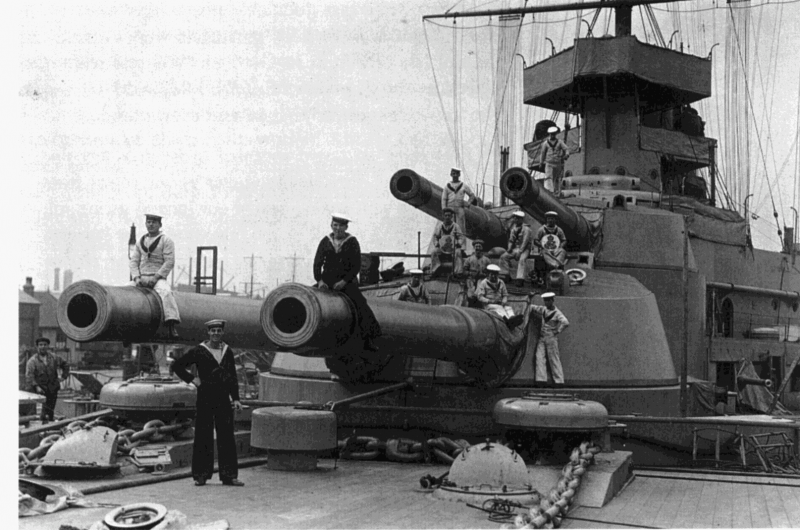
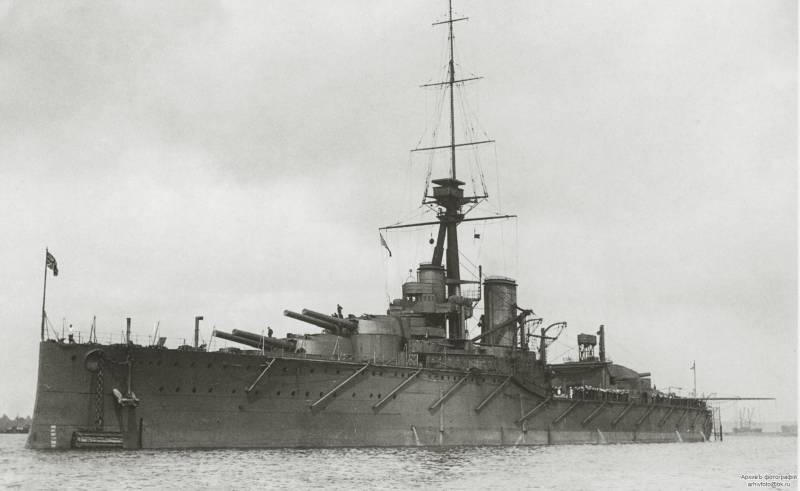
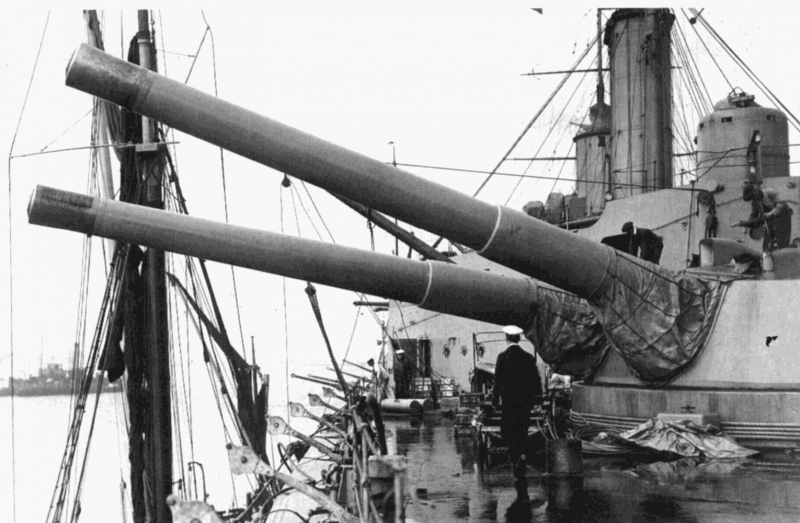
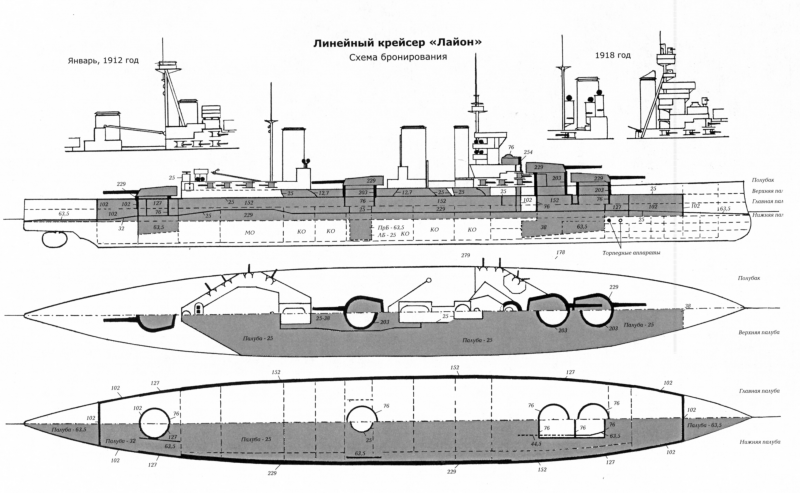
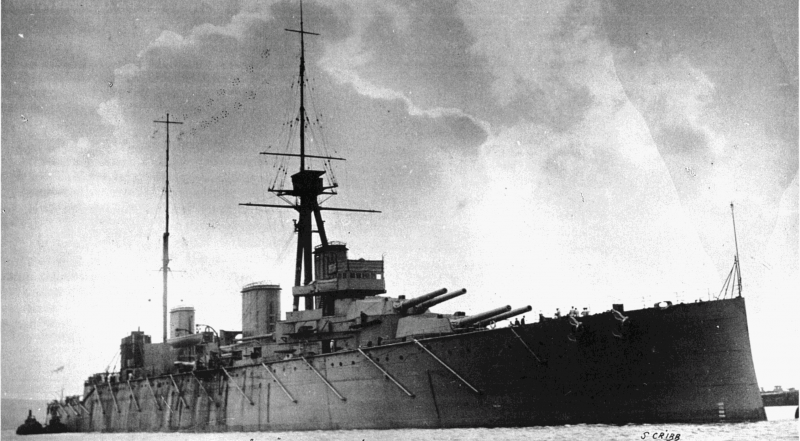
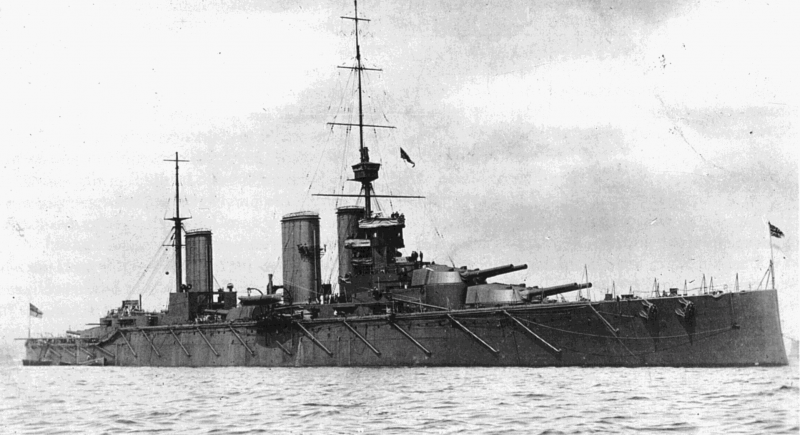
Information